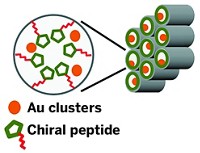Advertisement
Grab your lab coat. Let's get started
Welcome!
Welcome!
Create an account below to get 6 C&EN articles per month, receive newsletters and more - all free.
It seems this is your first time logging in online. Please enter the following information to continue.
As an ACS member you automatically get access to this site. All we need is few more details to create your reading experience.
Not you? Sign in with a different account.
Not you? Sign in with a different account.
ERROR 1
ERROR 1
ERROR 2
ERROR 2
ERROR 2
ERROR 2
ERROR 2
Password and Confirm password must match.
If you have an ACS member number, please enter it here so we can link this account to your membership. (optional)
ERROR 2
ACS values your privacy. By submitting your information, you are gaining access to C&EN and subscribing to our weekly newsletter. We use the information you provide to make your reading experience better, and we will never sell your data to third party members.
Synthesis
Cage-Catalyzed Condensation
The Knoevenagel condensation can be carried out in water, thanks to a palladium cage catalyst
by Bethany Halford
December 19, 2011
| A version of this story appeared in
Volume 89, Issue 51
With the help of a palladium-based cationic cage, researchers in Japan have coaxed a Knoevenagel condensation to take place under neutral conditions in water (J. Am. Chem. Soc., DOI: 10.1021/ja210068f). Knoevenagel condensations are reversible reactions involving attack of a carbanion of a 1,3-dicarbonyl compound on an aldehyde or a ketone followed by dehydration. It’s tough to do the transformation in water because the solvent pushes the equilibrium in favor of hydrated intermediates. And yet, similar condensation reactions are common in biological systems, thanks to the stabilization provided by the specialized environments of enzymes. Seeking to create a synthetic version of this stabilized environment, Makoto Fujita, Takashi Murase, and Yuki Nishijima of the University of Tokyo used a catalytic amount of a palladium cationic cage complex in several aqueous Knoevenagel condensations of aldehydes. They found that the cage-catalyzed reactions produced the desired condensation product in yields as high as 96%. The same reaction conditions without the cage produced only traces of the desired product. The researchers believe the cationic cage, with its hydrophobic core, can sequester organic substrates and stabilize ionic intermediates, much as enzymes do.





Join the conversation
Contact the reporter
Submit a Letter to the Editor for publication
Engage with us on Twitter